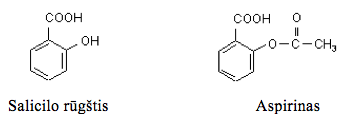Salicylates
These are esters of salicylic acid. Salicylates are nonsteroidal anti-inflammatory drugs, which also have antipyretic and analgesic effects. The anti-inflammatory effect of salicylates mostly depends on their ability to activate cyclooxygenase. This leads to decreased synthesis of cyclic peroxides and inflammatory mediators, such as thromboxanes, prostaglandins, and prostacyclins. Salicylates are moderate-strength analgesics. Their analgesic effect depends on the inhibition of prostaglandins, which are associated with the pain reaction. The analgesic effect of salicylates is both central – inhibiting pain perception areas, and peripheral – reducing the sensitivity of sensory nerve endings. Antipyretically, salicylates work only when the patient has a fever. This effect is also related to the inhibition of prostaglandin synthesis. A classic example of salicylates is aspirin (acetylsalicylic acid):

The upper limit of the therapeutic dose of salicylates is 350 mg/l. In cases of moderate severity, salicylate overdose occurs when their serum concentration is 500-750 mg/l. Severe intoxication – when their concentration in the blood serum is above 750 mg/l.
In case of salicylate poisoning:
– in mild cases: nausea, vomiting, pain in the abdomen, facial flushing, ringing in the ears;
– in moderate cases: sweating, hyperventilation, dehydration, deafness, tremors, respiratory alkalosis and metabolic acidosis (acidosis is more common in children);
– in severe cases: suppressed consciousness, drowsiness, delirium, pyrexia, coma, seizures (more common in children), hypoglycemia or hyperglycemia, hypokalemia, hyponatremia or hypernatremia, decreased prothrombin levels. Acute kidney failure, pulmonary edema or hypotension, shock may also occur.
In the case of intoxication, respiratory alkalosis and metabolic acidosis are typical. Salicylates stimulate the respiratory center, causing hyperventilation and resulting in respiratory alkalosis. Salicylates interact with the Krebs cycle, limiting the production of adenosine triphosphate, promoting lactate production, leading to an increase in the remaining anions, the anionic gap [Na+-(Cl–+HCO3–)] in plasma (normal range – 5-11 mmol/l), along with metabolic acidosis.
Salicylates stimulate peripheral glucose utilization in humans. Hypoglycemia may occur. Sometimes hyperglycemia, even ketoacidosis, is possible. Prolonged use of salicylates and maintaining their blood level at 2-2.2 mmol/l can lead to salicylate hepatitis.
It is believed that the effect of salicylates on the brain may increase the production of catecholamines, which can worsen the blood flow to the left ventricle of the heart, leading to the formation of necrotic foci in the myocardium due to inadequate oxygen demand.
Salicylates disrupt oxidation and phosphorylation processes in mitochondria.
Source | Glossary of Most Commonly Used Biomedical Terms and Concepts | Lithuanian University of Health Sciences | Academician Professor Antanas Praškevičius, Professor Laima Ivanovienė
